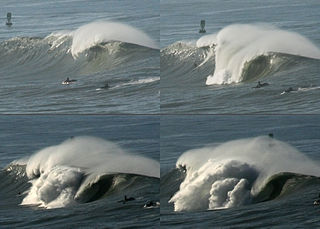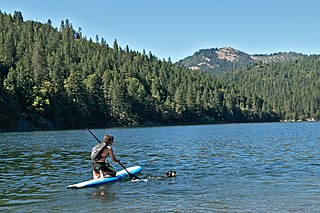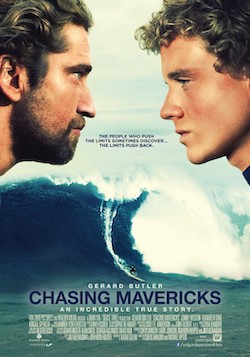Related Research Articles

Surfing is a surface water sport in which an individual, a surfer, uses a board to ride on the forward section, or face, of a moving wave of water, which usually carries the surfer towards the shore. Waves suitable for surfing are primarily found on ocean shores, but can also be found in standing waves in the open ocean, in lakes, in rivers in the form of a tidal bore, or in wave pools.

A surfboard is a narrow plank used in surfing. Surfboards are relatively light, but are strong enough to support an individual standing on them while riding an ocean wave. They were invented in ancient Hawaii, where they were known as papa he'e nalu in the Hawaiian language, and were usually made of wood from local trees, such as koa. They were often over 460 cm (15 ft) in length and extremely heavy. Major advances over the years include the addition of one or more fins (skegs) on the bottom rear of the board to improve directional stability, and numerous improvements in materials and shape.
Mark Richards, known as MR, is an Australian surfer who became a four-time world champion (1979–1982).

Mavericks is a surfing location in northern California outside Pillar Point Harbor, just north of the town of Half Moon Bay at the village of Princeton-by-the-Sea. After a strong winter storm in the northern Pacific Ocean, waves can routinely crest at over 25 ft (8 m) and top out at over 60 ft (18 m). Routinely, waves that break can be recorded on seismometers. The break is caused by an unusually shaped underwater rock formation.

Big wave surfing is a discipline within surfing in which experienced surfers paddle into, or are towed into, waves which are at least 20 feet high, on surf boards known as "guns" or towboards. Sizes of the board needed to successfully surf these waves vary by the size of the wave as well as the technique the surfer uses to reach the wave. A larger, longer board allows a rider to paddle fast enough to catch the wave and has the advantage of being more stable, but it also limits maneuverability and surfing speed.

Tow-in surfing is a surfing technique which uses artificial assistance to allow the surfer to catch faster moving waves than was traditionally possible when paddling by hand. Tow-in surfing was invented by surfers who wanted to catch big waves and break the 30 ft (9 m) barrier. It has been one of the biggest breakthroughs in surfing history.
Mark Sheldon Foo was a professional surfer who favored big wave surfing. Foo drowned while surfing at Mavericks, Half Moon Bay, California, in 1994.
Greg Noll was an American pioneer of big wave surfing and a prominent longboard shaper. Nicknamed "Da Bull" by Phil Edwards in reference to his physique and way of charging down the face of a wave, he was on the U.S. lifeguard team that introduced Malibu boards to Australia around the time of the 1956 Summer Olympics in Melbourne. He produced a "legendary" series of five Search for Surf films.

Peʻahi is a place on the north shore of the island of Maui in the U.S. state of Hawaii. It has lent its name to a big wave surfing break, also known as Jaws.
Skurfing is a towed water sport in which an individual is pulled behind a boat on a tow rope. The sport uses a skurfboard, which is a floating platform the user balances on, similar to a surfboard but typically much shorter, with two foot-straps that prevent falling off the board and three fins positioned on the bottom that make it easier to maneuver when the board is being towed. The word itself is a portmanteau of skiing and surfing. Skurfing is often considered the precursor to wakeboarding.

The riding of waves has likely existed since humans began swimming in the ocean. In this sense, bodysurfing is the oldest type of wave-catching. Undoubtedly ancient sailors learned how to ride wave energy on many styles of early boats. Archaeological evidence even suggests that ancient cultures of Peru surfed on reed watercraft for fishing and recreation up to five thousand years ago. However, standing up on what is now called a surfboard is a relatively recent innovation developed by the Polynesians. The influences for modern surfing can be directly traced to the surfers of pre-contact Hawaii.

Paddleboarding is a water sport in which participants are propelled by a swimming motion using their arms while lying or kneeling on a paddleboard or surfboard in the ocean or other body of water. Paddleboarding is usually performed in the open ocean, with the participant paddling and surfing unbroken swells to cross between islands or journey from one coastal area to another.

Hobart "Hobie" Alter was an American surf and sailing entrepreneur and pioneer, creator of the Hobie Cat catamarans, and founder of the Hobie company.

Standup paddleboarding (SUP) is a water sport born from surfing with modern roots in Hawaii. Standup paddleboarders stand on boards that are floating on the water and use a paddle to propel themselves through the water. The sport was documented in a 2013 report that identified it as the outdoor sporting activity with the most first-time participants in the United States that year. Variations include flat water paddling, racing, surfing, whitewater SUP, yoga, and fishing.

Greg Long is an American surfer from San Clemente, California. He has won the Quiksilver Big Wave Invitational, in memory of Eddie Aikau at Waimea Bay, the Red Bull Titans of Mavericks event held at Mavericks in Northern California, and the Red Bull Big Wave Africa event held at Dungeons in Hout Bay, South Africa. Additionally, he is the most decorated surfer in the Billabong XXL Global Big Wave Awards. He is widely regarded as one of the best big wave surfers in the world.

Chasing Mavericks is a 2012 American biographical drama film about the life of American surfer Jay Moriarity. It was directed by Curtis Hanson and Michael Apted, and stars Gerard Butler, Elisabeth Shue, Abigail Spencer, and Leven Rambin.
Donald Moke Takayama was an American professional surfer and surfboard shaper. Originally a longboard surfer, Takayama won the Master's division of the United States Surfing Champions in 1971, 1972 and 1973. Hawaiian born, Takayama learned to surf at Waikiki Beach and moved to California in the mid-1950s. Takayama died of complications from heart surgery; he is survived by his wife and four daughters.
Chris Christenson is an American surfboard shaper, craftsman, and outdoor enthusiast.

Surfing in the United States is a popular hobby in coastal areas, and more recently due to the invention of wave pools, inland regions of the country. It contributes to a lifestyle and culture in which millions participate and which millions more have an interest. USA surfing is the governing body for the sport of surfing in the United States, with surf leagues such as the World Surf League available in the country. Surfing can be traced back to 17th Century Hawaii and has evolved over time into the professional sport it is today, with surfing being included for the first time in the 2020 Summer Olympics in Tokyo.
Chris Bertish is a South African surfer, stand-up paddleboarder, adventurer, and motivational speaker. In 2004 he gained recognition as the owner of 'Best Cribbar Barrel Vision Ever' after he pulled into a giant closeout at the infamous big wave spot in Cornwall. He won the Mavericks Big Wave Surf contest in 2009. In March 2017 he completed the first solo, unsupported stand-up paddle board (SUP) crossing of the Atlantic Ocean. He did it while supporting charitable organizations. He has also set other SUP world records. His efforts moved an obscure sport onto the forefront of many important media outlets.
References
- Matt Warshaw: Maverick's: The Story of Big-Wave Surfing, Chronicle Books, ISBN 0-8118-2652-X
- Wild Film: Wild Stars Bio and interview with Clark.